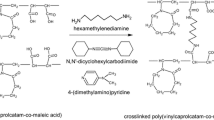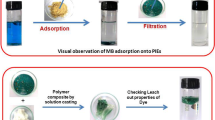Abstract
Discharging methylene blue (MB) dye into waste streams has caused severe environmental problems to the aquatic life ecosystem and hence to human beings. Hence, this work investigated the feasibility to use polypropylene (PP) film waste to prepare carboxyl/nitro-functionalized PP microparticles (COOH/NO2-PP) for the adsorption of MB from aqueous solutions. PP powder was prepared by dissolution/precipitation method from PP film waste, followed by treatment with nitric acid at 130 °C. ATR-FTIR analysis proved the structure of PP and the existence of carboxyl and nitro groups on the surface. The enhancement in surface hydrophilicity of PP after treatment was confirmed by contact angle measurements. The effects of polymer dosage, pH, and contact time on the adsorption process were studied. The results showed that the removal of MB from water increased with increasing these parameters. The kinetic and equilibrium studies showed that the Langmuir isotherm and pseudo-second-order kinetic model fitted the experimental data well. This suggested that the adsorption process was chemisorption. A maximum adsorption capacity of 14.33 mg MB/g-polymer was achieved at 23 °C and neutral pH (6.5). The free energy change had a negative value, which signifies the spontaneity of the adsorption process. Thereby, waste PP can be converted into useful adsorbents for treating cationic dye-polluted water.
Graphic abstract







Similar content being viewed by others
References
Cao M, Shen Y, Yan Z, Wei Q, Jiao T, Shen Y, Han Y, Wang Y, Wang S, Xia Y, Yue T (2021) Extraction-like removal of organic dyes from polluted water by the graphene oxide/PNIPAM composite system. Chem Eng J 405:126647
Santoso E, Ediati R, Kusumawati Y, Bahruji H, Sulistiono DO, Prasetyoko D (2020) Review on recent advances of carbon based adsorbent for methylene blue removal from waste water. Mater Today Chem 16:100233
Lv Q, Qiu Y, Wu M, Wang L (2020) Poly(acrylic acid)/poly(acrylamide) hydrogel adsorbent for removing methylene blue. J Appl Polym Sci 137:49322
Gupta VK (2009) Application of low-cost adsorbents for dye removal–a review. J Environ Manag 90:2313–2342
Yagub MT, Sen TK, Afroze S, Ang HM (2014) Dye and its removal from aqueous solution by adsorption: a review. Adv Colloid Interface Sci 209:172–184
Rafatullah M, Sulaiman O, Hashim R, Ahmad A (2010) Adsorption of methylene blue on low-cost adsorbents: a review. J Hazard Mater 177:70–80
Holkar CR, Jadhav AJ, Pinjari DV, Mahamuni NM, Pandit AB (2016) A critical review on textile wastewater treatments: possible approaches. J Environ Manag 182:351–366
Beaugeard V, Muller J, Graillot A, Ding X, Robin J, Monge S (2020) Acidic polymeric sorbents for the removal of metallic pollution in water: a review. React Funct Polym 152:104599
Haji A, Shoushtari AM, Abdouss M (2015) Desalination and water treatment plasma activation and acrylic acid grafting on polypropylene nonwoven surface for the removal of cationic dye from aqueous media. Desalin Water Treat 53:3632–3640
Morsy FA, Elsayad SY, Bakry A, Eid MA (2006) Surface properties and printability of polypropylene film treated by an air dielectric barrier discharge plasma. Surf Coat Int Part B Coat Trans 89:49–55
Zhang C, Bai Y, Liu W (2014) The approaches for promoting PP adhesion based on the surface modification. J Adhes Sci Technol 28:454–465
Bakry A, Darwish MSA, El Naggar AMA (2018) Assembling of hydrophilic and cytocompatible three-dimensional scaffolds based on aminolyzed poly(l-lactide) single crystals. New J Chem 42:16930–16939
Zhang H, Fang D, Kong Z, Wei J, Wu X, Shen S (2018) Enhanced adsorption of phthalic acid esters (PAEs) from aqueous solution by alkylbenzene-functionalized polypropylene nonwoven and its adsorption mechanism insight. Chem Eng J 331:406–415
Fu P, Tomalia MK (2004) Carboxyl-terminated isotactic polypropylene. Preparation. Macromolecules 37:267–275
Bakry A, Darwish MSA (2018) Hyaluronic acid and chitosan surface grafted polylactide single crystals as hydrophilic building blocks for scaffold materials. Polym Sci Ser A 60:757–769
Bakry A, Martinelli A, Bizzarri M, Cucina A, D’Ilario L, Francolini I, Piozzi A, Proietti S (2012) A new approach for the preparation of hydrophilic poly(L-lactide) porous scaffold for tissue engineering by using lamellar single crystals. Polym Int 61:1177–1185
Inaam M, Taimur S, Khan IA, Yasin T, Ali SW (2019) Surface modification of polypropylene waste by the radiation grafting of styrene and upcycling into a cation-exchange resin. J Appl Polym Sci 136:47145
Won SW, Vijayaraghavan K, Mao J, Kim S, Yun YS (2009) Reinforcement of carboxyl groups in the surface of Corynebacterium glutamicum biomass for effective removal of basic dyes. Bioresour Technol 100:6301–6306
Martinelli A, Bakry A, D’Ilario L, Francolini I, Piozzi A, Taresco V (2014) Release behavior and antibiofilm activity of usnic acid-loaded carboxylated poly(l-lactide) microparticles. Eur J Pharm Biopharm 88:415–423
Garcia JM, Robertson ML (2017) The future of plastics recycling. Science 358:870–872
Poulakis JG, Papaspyrides CD (1997) Recycling of polypropylene by the dissolution/reprecipitation technique: I. A model study. Resour Conserv Recycl 20:31–41
Horodytska O, Valdés FJ, Fullana A (2018) Plastic flexible films waste management–a state of art review. Waste Manag 77:413–425
Bakry A (2019) Synergistic effects of surface grafting with heparin and addition of poly(d, l-lactide) microparticles on properties of poly(l-lactide) single crystals scaffolds. J Appl Polym Sci 136:47797
Bakry A (2020) Synergistic effects of surface aminolysis and hydrolysis on improving fibroblast cell colonization within poly (L-lactide) scaffolds. J Appl Polym Sci 138:49643
Chandraiahgari CR, De Bellis G, Martinelli A, Bakry A, Tamburrano A, Sarto MS (2015) Nanofiller induced electroactive phase formation in solution derived poly(vinylidene fluoride) polymer composites. In: 2015 IEEE 15th Int Conf Nanotechnol (IEEE-NANO), pp 1346–1349
Bakry A, Aversano R, D’Ilario L, Di Lisio V, Francolini I, Piozzi A, Martinelli A (2016) Flexible aliphatic poly(isocyanurate-oxazolidone) resins based on poly(ethylene glycol) diglycidyl ether and 4,4′-methylene dicyclohexyl diisocyanate. J Appl Polym Sci 133:43404. https://doi.org/10.1002/app.43404
Darwish MSAMSA, Bakry A, Al-Harbi LMLM, Khowdiary MMMM, El-Henawy AAA, Yoon J (2020) Core/shell PA6@ Fe3O4 nanofibers: magnetic and shielding behavior. J Dispers Sci Technol 41:1711–1719
Matos JP, Terezinha M, Sansiviero C, Lago RM (2010) Surface chemical modification of polypropylene fiber waste by H2SO4: mechanistic investigation and application as cation-exchange adsorbent. J Appl Polym Sci 115:3586–3591
Hock CW (1965) J Polym Sci B 3:573
Urbaniak-Domagala W (2011) Pretreatment of polypropylene films for the creation of thin polymer layers. Part 1: the use of chemical, electrochemical, and UV methods. J Appl Polym Sci 122:2071–2080
Morshedy AS, Taha MH, Abd El-Aty DM, Bakry A, El Naggar AMA (2021) Solid waste sub-driven acidic mesoporous activated carbon structures for efficient uranium capture through the treatment of industrial phosphoric acid. Environ Technol Innov 21:101363
Casini G, Petrone L, Bakry A, Francolini I, Di Bonito P, Giorgi C, Martinelli A, Piozzi A, D’Ilario L (2010) Functionalized poly(l-lactide) single crystals coated with antigens in development of vaccines. J Control Release 148:e105–e111
Crini G (2008) Kinetic and equilibrium studies on the removal of cationic dyes from aqueous solution by adsorption onto a cyclodextrin polymer. Dye Pigment 77:415–426
Lagergren SK (1898) About the theory of so-called adsorption of soluble substances. Sven Vetenskapsakademiens Handl 24:1–39
Ho YS, Mckay G (1999) Pseudo-second order model for sorption processes. Process Biochem 34:451–465
Weber WJ, Morris JC (1963) Kinetics of adsorption on carbon from solution. J Sanit Eng Div 89:31–60
Low MJD (1960) Kinetics of chemisorption of gases on solids. Chem Rev 60:267–312
Fan S, Wang Y, Wang Z, Tang J, Tang J, Li X (2017) Removal of methylene blue from aqueous solution by sewage sludge-derived biochar: adsorption kinetics, equilibrium, thermodynamics and mechanism. J Environ Chem Eng 5:601–611
Vadivelan V, Kumar KV (2005) Equilibrium, kinetics, mechanism, and process design for the sorption of methylene blue onto rice husk. J Colloid Interface Sci 286:90–100
Pandey PK, Sharma SK, Sambi SS (2010) Kinetics and equilibrium study of chromium adsorption on zeoliteNaX. Int J Environ Sci Technol 7:395–404
Feng J, Zhu J, Lv W, Li J, Yan W (2015) Effect of hydroxyl group of carboxylic acids on the adsorption of Acid Red G and Methylene Blue on TiO2. Chem Eng J 269:316–322
Dinh V, Huynh T, Le HM, Nguyen V (2019) Methylene blue and chromium (III) from aqueous. RSC Adv 9:25847–25860
Jiaqi Z, Yimin D, Danyang L, Shengyun W, Liling Z, Yi Z (2019) Synthesis of carboxyl-functionalized magnetic nanoparticle for the removal of methylene blue. Colloid Surf A Physicochem Eng Asp 572:58–66
Zhang B, Yan J, Li G, Wang Z (2019) Carboxyl-, hydroxyl-, and nitro-functionalized porous polyaminals for highly selective CO2 capture. ACS Appl Polym Mater 1:1524–1531
Temel S, Yaman E, Ozbay N, Gokmen FO (2020) Synthesis, characterization and adsorption studies of nanocomposite hydrogels and SiO2 effect on removal capacity of methylene blue dye. J Serb Chem Soc 85:939–952
Pradhan AC, Paul A, Rao GR (2017) Sol-gel-cum-hydrothermal synthesis of mesoporous Co-Fe @ Al2O3 − MCM-41 for methylene blue remediation. J Chem Sci 129:381–395
Author information
Authors and Affiliations
Corresponding author
Rights and permissions
About this article
Cite this article
Bakry, A., Darwish, M.S.A. & Hassanein, T.F. Adsorption of methylene blue from aqueous solutions using carboxyl/nitro-functionalized microparticles derived from polypropylene waste. Iran Polym J 31, 185–197 (2022). https://doi.org/10.1007/s13726-021-00979-w
Received:
Accepted:
Published:
Issue Date:
DOI: https://doi.org/10.1007/s13726-021-00979-w




